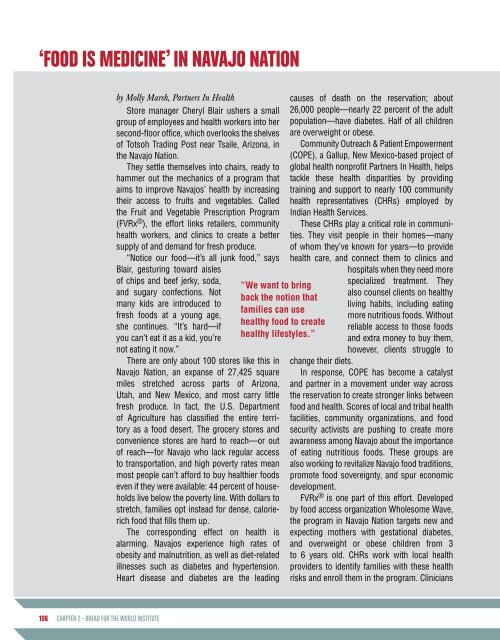THE NOURISHING EFFECT
HR2016-Full-Report-Web
HR2016-Full-Report-Web
Create successful ePaper yourself
Turn your PDF publications into a flip-book with our unique Google optimized e-Paper software.
‘FOOD IS MEDICINE’ IN NAVAJO NATION<br />
by Molly Marsh, Partners In Health<br />
Store manager Cheryl Blair ushers a small<br />
group of employees and health workers into her<br />
second-floor office, which overlooks the shelves<br />
of Totsoh Trading Post near Tsaile, Arizona, in<br />
the Navajo Nation.<br />
They settle themselves into chairs, ready to<br />
hammer out the mechanics of a program that<br />
aims to improve Navajos’ health by increasing<br />
their access to fruits and vegetables. Called<br />
the Fruit and Vegetable Prescription Program<br />
(FVRx ® ), the effort links retailers, community<br />
health workers, and clinics to create a better<br />
supply of and demand for fresh produce.<br />
“Notice our food—it’s all junk food,” says<br />
Blair, gesturing toward aisles<br />
of chips and beef jerky, soda,<br />
and sugary confections. Not<br />
many kids are introduced to<br />
fresh foods at a young age,<br />
she continues. “It’s hard—if<br />
you can’t eat it as a kid, you’re<br />
not eating it now.”<br />
There are only about 100 stores like this in<br />
Navajo Nation, an expanse of 27,425 square<br />
miles stretched across parts of Arizona,<br />
Utah, and New Mexico, and most carry little<br />
fresh produce. In fact, the U.S. Department<br />
of Agriculture has classified the entire territory<br />
as a food desert. The grocery stores and<br />
convenience stores are hard to reach—or out<br />
of reach—for Navajo who lack regular access<br />
to transportation, and high poverty rates mean<br />
most people can’t afford to buy healthier foods<br />
even if they were available: 44 percent of households<br />
live below the poverty line. With dollars to<br />
stretch, families opt instead for dense, calorierich<br />
food that fills them up.<br />
The corresponding effect on health is<br />
alarming. Navajos experience high rates of<br />
obesity and malnutrition, as well as diet-related<br />
illnesses such as diabetes and hypertension.<br />
Heart disease and diabetes are the leading<br />
“We want to bring<br />
back the notion that<br />
families can use<br />
healthy food to create<br />
healthy lifestyles.”<br />
causes of death on the reservation; about<br />
26,000 people—nearly 22 percent of the adult<br />
population—have diabetes. Half of all children<br />
are overweight or obese.<br />
Community Outreach & Patient Empowerment<br />
(COPE), a Gallup, New Mexico-based project of<br />
global health nonprofit Partners In Health, helps<br />
tackle these health disparities by providing<br />
training and support to nearly 100 community<br />
health representatives (CHRs) employed by<br />
Indian Health Services.<br />
These CHRs play a critical role in communities.<br />
They visit people in their homes—many<br />
of whom they’ve known for years—to provide<br />
health care, and connect them to clinics and<br />
hospitals when they need more<br />
specialized treatment. They<br />
also counsel clients on healthy<br />
living habits, including eating<br />
more nutritious foods. Without<br />
reliable access to those foods<br />
and extra money to buy them,<br />
however, clients struggle to<br />
change their diets.<br />
In response, COPE has become a catalyst<br />
and partner in a movement under way across<br />
the reservation to create stronger links between<br />
food and health. Scores of local and tribal health<br />
facilities, community organizations, and food<br />
security activists are pushing to create more<br />
awareness among Navajo about the importance<br />
of eating nutritious foods. These groups are<br />
also working to revitalize Navajo food traditions,<br />
promote food sovereignty, and spur economic<br />
development.<br />
FVRx ® is one part of this effort. Developed<br />
by food access organization Wholesome Wave,<br />
the program in Navajo Nation targets new and<br />
expecting mothers with gestational diabetes,<br />
and overweight or obese children from 3<br />
to 6 years old. CHRs work with local health<br />
providers to identify families with these health<br />
risks and enroll them in the program. Clinicians<br />
106 CHAPTER 2 • BREAD FOR <strong>THE</strong> WORLD INSTITUTE


